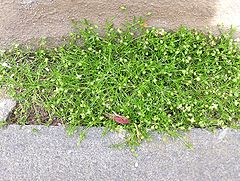Sagina
| Sagina subsp. var. | Pearlwort | |||||||||||||||||||||||||||||||||||||||||||||||||||||||
|---|---|---|---|---|---|---|---|---|---|---|---|---|---|---|---|---|---|---|---|---|---|---|---|---|---|---|---|---|---|---|---|---|---|---|---|---|---|---|---|---|---|---|---|---|---|---|---|---|---|---|---|---|---|---|---|---|

|
|
| ||||||||||||||||||||||||||||||||||||||||||||||||||||||
| ||||||||||||||||||||||||||||||||||||||||||||||||||||||||
Sagina (like Colobanthus called "pearlworts") is a genus of 20–30 species of flowering plants in the family Caryophyllaceae. These are flowering herbs native to temperate regions of the Northern Hemisphere extending south to tropical mountain areas at high altitudes, reaching just south of the equator in Africa. They are small annual or perennial herbaceous plants, erect or prostrate, growing to 5–15 cm tall or broad. The leaves are opposite, often in tight whorl-like clusters, simple linear, typically 5–20 mm long. The flowers are solitary or in small cymes, with five green sepals and five white petals; the petal size relative to the sepal size is useful in species identification. The fruit is a small capsule containing several seeds.[1][2][3][4]
| Standard Cyclopedia of Horticulture |
|---|
|
Sagina (Latin, fatness; perhaps alluding to the forage value). Caryophyllaceae. Pearlwort. Annual or perennial tufted herbs, sometimes used for edging. Leaves awl-shaped: fls. small, usually comparatively long-stemmed; sepals 4-5; petals 4-5, entire or slightly emarginate, minute or none; stamens equal in number to the sepals or twice as many; ovary 1-loculed, many-seeded; styles of the same number as the sepals and alternate with them.—About 50 species, natives of the temperate and colder regions of the world.
|
- More information about this species can be found on the genus page.
Cultivation
- Do you have cultivation info on this plant? Edit this section!
Propagation
- Do you have propagation info on this plant? Edit this section!
Pests and diseases
- Do you have pest and disease info on this plant? Edit this section!
Species
|
|
Gallery
If you have a photo of this plant, please upload it! Plus, there may be other photos available for you to add.
References
- Standard Cyclopedia of Horticulture, by L. H. Bailey, MacMillan Co., 1963
External links
- w:Sagina. Some of the material on this page may be from Wikipedia, under the Creative Commons license.
- Sagina QR Code (Size 50, 100, 200, 500)
Cite error:
<ref> tags exist, but no <references/> tag was found
